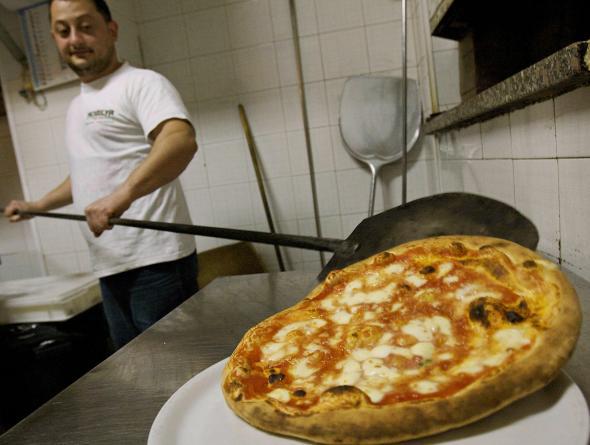A few weeks ago, I went to a newish Italian place in my new neighborhood in Brooklyn. Lea is one of those moderately upscale pizzerias, with a wood-burning oven, more than one menu item containing beets, and menu subsections written in Italian (with the flatbread portion labeled “Pizze”). I ordered the white pizza with roasted Brussels sprouts, ricotta, and Parmesan, which was just as delicious as it sounds.
There was just one hiccup during an otherwise delightful meal: My pizza arrived in an intact circle. “How many slices would you like?” asked the waitress, wielding a pizza wheel. I had never given much thought to the ideal number of pizza slices, but I settled on four, because I thought it would take her less time to cut four slices than six or eight. It did, but it still took a good minute or two before everyone’s pizza—there were four of us at the table—had been cut. (Perhaps needless to say, it’s more challenging to cut a pizza on a curved plate than on a flat cutting board.)
I like Lea a lot, but I found this particular flourish distracting, unnecessary, and baffling. (Were they afraid that I’d think my pizza was cobbled together from disparate slices of other pizzas if they didn’t cut it before my eyes?) I often feel this way about tableside service, which, according to the Wall Street Journal, was “making a comeback” as of late 2013. No longer content with merely grinding pepper over salads and pasta, restaurateurs are carving ducks, smoking oysters, and flambéing veal chops in front of their patrons—and now, apparently, slicing pizza, too.
In some instances, the theater is a big part of what patrons are paying for: Eleven Madison Park’s $225 tasting menu, for instance, is practically a variety show of impressive tableside preparations and garnishes, a showcase of the breathtaking skill set of world-class servers. But what about restaurants that aim to create a cozy environment where diners can enjoy a glass of wine, a relaxed meal, and a good conversation with friends?
Under these circumstances, I would argue that tableside service should be both brief and truly necessary, for either aesthetic or gustatory reasons. By brief, I mean a tableside intervention shouldn’t interrupt a conversation long enough for the parties involved to forget what it is they were talking about. By necessary, I mean that a dish will suffer in appearance or flavor if a final step isn’t taken immediately before consumption. For instance, some soups will slosh over the sides of the bowl, or just look messy, if they’re not poured from a tureen into one’s bowl at the table. And if you order something that is lit on fire—crêpes suzette, bananas foster, tiki cocktails—well, watching it flame out in front of you is the whole point. If it’s not truly necessary, I am happy for the kitchen staff to do it on their own time behind closed doors.
If it can’t meet both of those criteria, tableside service should at least be optional—either clearly marked on the menu so drama-averse patrons can steer clear, or truly superfluous, like pepper grinding. (No one needs pepper ground on top of their food before they’ve even had a chance to taste it.) The seemingly obligatory nature of the pizza slicing at Lea is what, in hindsight, bothered me about it: I felt like I couldn’t refuse the service.
Just in case I was missing something, I got in touch with Lea’s management to ask about the rationale behind their tableside pizza slicing: Was it meant to indicate that the pizza was truly fresh from the oven? Were they worried that their pizzas would look too messy if they were sliced before serving? Had anyone actually complained about pizza that had been sliced behind the scenes?
When I told Lea co-owner Ben Heemskerk over the phone that I had mixed feelings about the tableside pizza-cutting, he said, “Me too.” Heemskerk explained that the policy arose from the tension between his chef (who thought that pizza looked much better unsliced) and consumers (who generally expect that pizza be sliced). Then there’s the issue of sharing: “Sometimes if it’s kids or it’s people sharing a pizza, they want it in six slices or eight slices, not four, and then we can accommodate that,” said Heemskerk. He also likes the talking and joking between servers and patrons that the slicing ritual spurs.
And he said something that surprised me: It turns out the pizza slicing is optional. “A lot of people actually say, ‘Nah, that’s OK,’ and they have a steak knife or another knife there so that they can cut it themselves,” Heemskerk told me. (Pizza is traditionally served unsliced in Naples.) So now I know I have options the next time a server approaches me with a pizza wheel—although if it’s a choice between sliced pizza and pizza I have to attack with a knife and fork, I’ll take the slicing, whether it’s done in front of me or behind the scenes.
